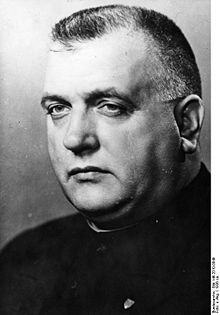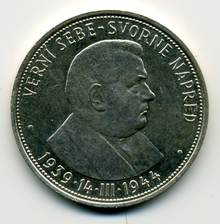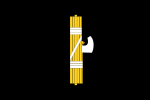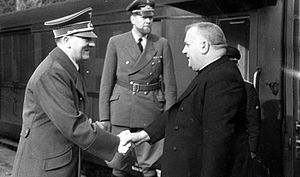- Jozef Tiso
-
"Tiso" redirects here. For other people with the same surname, see Tiso (surname).
Jozef Tiso 
President of Slovakia In office
26 October 1939 – 3 April 1945Preceded by Office created Succeeded by Office abolished Personal details Born 13 October 1887
Nagybiccse (today Bytča)
Austria-HungaryDied 18 April 1947 (aged 59)
Bratislava, CzechoslovakiaPolitical party Slovak People's Party Profession Politician, Cleric, Roman Catholic priest Religion Roman Catholicism Jozef Tiso (Hungarian: Tisza József; 13 October 1887 – 18 April 1947) was a Slovak Roman Catholic priest, politician of the Slovak People's Party, and Nazi collaborator. Between 1939 and 1945, Tiso was the head [1][2][3][4][5][6] of the Slovak State, a satellite state of Nazi Germany. After the end of World War II, Tiso was convicted and hanged for his activities in support of Nazism.
Contents
Early life
Born in Nagybiccse (present-day Bytča, Slovakia) to Slovak parents in Austria-Hungary. The Bishop of Nitra (Nyitra), Imre Bende, offered Tiso a chance to study for the priesthood, and, in 1911, Tiso graduated from the prestigious Pázmáneum in Vienna. His early ministry was spent as an assistant priest in three parishes in today's Slovakia. After brief frontline service as a field curate in World War I, he was appointed as the Spiritual Director of the Nitra seminary by Bende's successor, Vilmos Batthyány. Tiso was also active at this time as a school teacher and journalist. His articles for the local paper would later be controversial because of their strong support for the Hungarian war cause.
With the collapse of Austria-Hungary and the creation of Czechoslovakia in 1918, Tiso suddenly embraced politics as a career, at the same time declaring himself in public as a Slovak. Within a few weeks, he had joined the Slovak People's Party. From 1921 to 1923, he served as the secretary to the new Slovak bishop of Nitra, Karol Kmeťko. During the same period, political agitation earned Tiso two convictions for incitement, one of which resulted in a short incarceration. Displeased, Kmeťko dropped him as secretary in 1923, but retained him as a Professor of Theology. In 1924, Tiso left Nitra to become parish priest and then dean of Bánovce nad Bebravou. His dedication to this parish would become legendary, and he would remain its very active priest even during his presidency.[7]
 50 Slovak koruna silver coin issued for the fifth anniversary of the Slovak Republic (1939–1945) with an effigy of the slovak president Jozef Tiso.
50 Slovak koruna silver coin issued for the fifth anniversary of the Slovak Republic (1939–1945) with an effigy of the slovak president Jozef Tiso.
Political ascent
Tiso became one of the leaders of the Slovak People's Party (otherwise known as the Ľudáks), which had been founded by Father Andrej Hlinka in 1913, while Austria-Hungary still ruled Slovakia. The party's interwar platform demanded the autonomy of Slovakia within a Czechoslovak framework. After 1925, the Ľudáks were the largest party in Slovakia. They were one of two explicitly Slovak parties in Slovakia, the others either representing national minorities or structuring themselves as Czechoslovak. Although Tiso seemed destined in the late 1920s to soon succeed Hlinka, he spent the 1930s instead competing for Hlinka's mantle with party radicals, most notably Karol Sidor. When Hlinka died in 1938, Tiso emerged only as de facto leader of the party. He, however, quickly consolidated his control of the party, becoming its undisputed chairman in fall 1939.
Tiso first ran for parliament in 1920. Although the electoral results from his district were bright spots in what was otherwise a disappointing election for the Ľudáks, the party did not reward him with a legislative seat. Tiso, however, easily claimed one in the 1925 election, which also resulted in a breakthrough victory for the party. Until 1938, he was a fixture in the Czechoslovak parliament in Prague. From 1927 to 1929, in a failed attempt to integrate the Ľudáks into the Czechoslovak polity, he also served as the Czechoslovak Minister of Health and Physical Education.[8]
Adolf Hitler's Germany annexed the Sudetenland (the German part of Czechoslovakia) and the Czechoslovak president Edvard Beneš fled the country in October 1938. During the chaos which resulted, the Slovaks (who had lacked any form of autonomy within Czechoslovakia) declared their autonomy within Czechoslovakia and Tiso, as leader of the Slovak People's Party, became (until 9 March 1939) the premier of the autonomous Slovak region. Hungary, having never really accepted the separation of Slovakia from its control in 1918, took advantage of the situation and managed to persuade Germany and Italy to force Slovakia to let Hungarian troops occupy one third of Slovak territory in November 1938, by the so-called Vienna Award (Vienna Arbitration).
Part of a series on Fascism  Core tenetsNationalism · Totalitarianism · Single party state · Dictatorship · Collectivism · Social Darwinism · Militarism · Mixed economy · Class collaboration · Third PositionTopicsWorksThe Doctrine of Fascism · Fascist manifesto · Mein Kampf · My Autobiography · The Myth of the Twentieth Century · Zaveshchanie russkogo fashistaInternational organizationsHistoryListsRelated topicsAnti-fascism · Clerical fascism · Fascist (epithet) · Glossary of Fascist Italy · Neo-Fascism · Racism · Social fascism · Palingenetic ultranationalism
Core tenetsNationalism · Totalitarianism · Single party state · Dictatorship · Collectivism · Social Darwinism · Militarism · Mixed economy · Class collaboration · Third PositionTopicsWorksThe Doctrine of Fascism · Fascist manifesto · Mein Kampf · My Autobiography · The Myth of the Twentieth Century · Zaveshchanie russkogo fashistaInternational organizationsHistoryListsRelated topicsAnti-fascism · Clerical fascism · Fascist (epithet) · Glossary of Fascist Italy · Neo-Fascism · Racism · Social fascism · Palingenetic ultranationalismFascism portal
Politics portalIn the light of this situation, all Czech or Slovak political parties in Slovakia (except for the Communists) voluntarily joined forces and set up the "Hlinka's Slovak People's Party - Party of Slovak National Unity" in November 1938, which created the basis for the future authoritarian regime in Slovakia. (The same happened in the Czech part of the country two weeks later for Czech parties.) In January 1939, the Slovak government officially prohibited all parties apart from the Party of Slovak National Unity, the "Deutsche Partei" (a party of Germans in Slovakia) and the "Unified Hungarian Party" (a party of Hungarians in Slovakia).
From February 1939, representatives of Germany - planning to occupy the Czech part and basically not interested in Slovakia - started to officially persuade Slovak politicians to declare the independence of Slovakia. On 9 March 1939, Czech troops occupied Slovakia and Tiso lost his post of Prime Minister.[citation needed] On 13 March 1939, Adolf Hitler lost his patience. He invited Tiso - as the deposed prime minister - to Berlin, and personally forced him to immediately (as he said "in a flash") declare the independence of Slovakia under German "protection", otherwise Germany would allow Hungary (and partly Poland) to annex the remaining territory of Slovakia. Under these circumstances, Tiso spoke by phone to the Czechoslovak president Emil Hácha and to the then Prime Minister of Slovakia, Karol Sidor, and they agreed to convene the Slovak parliament the next day and let it decide. On March 14, the Slovak parliament unanimously declared the independence of Slovakia, and on March 15, Germany invaded the remaining Czech lands - exactly according to German plans.
Tiso served as the Prime Minister of independent Slovakia from 14 March 1939 until 26 October 1939. On 26 October he became President of Slovakia (separate from the Prime Ministerial office). On October 1, 1939 he officially became the president of the Slovak People's Party. According to the pro-Nazi nationalist fashion, from 1942 he was self-styled Vodca "Leader", an imitation in the national language of Führer (compare in that article)[citation needed].
Policies
 Jozef Tiso with Adolf Hitler
Jozef Tiso with Adolf Hitler
The "independence" of Slovakia remained largely illusory in the sense that Slovakia was a German puppet state. The Slovak People's Party functioned as almost the sole legal political organisation in Slovakia. The Party under Tiso's leadership aligned itself with Nazi policy on anti-Semitic legislation in Slovakia. This was no hard task, given Hlinka's policy of a "Slovakia for the Slovaks", a line vehemently adhered to by Jozef Tiso. The respective main act was the so-called Jewish Code. Under the anti-Semitic Jewish Code, Jews in Slovakia could not own any real estate or luxury goods, were excluded from public jobs and free occupations, could not participate in sport or cultural events, were excluded from secondary schools and universities, and were required to wear the star of David in public. Tiso himself - like many people in Central Europe at that time - had definite anti-Semitic views (as some of his own letters from the end of World War II suggest). In general, opinions differ widely on his role in the Jewish deportations from Slovakia, but it is known that he adhered to the Nazi line to a considerable extent. The Slovak Parliament accepted a bill (May 1942) unanimously deciding the deportation of the Jews. It may be interesting to note that the only voice (vote) disagreeing came from the representative of the Hungarian minority in Slovakia (Eszterhazy). Some sources prefer the view that Tiso supported the deportations tacitly; other sources point out that the first deportations had to take place secretly behind his back due to his "personal opposition". As to the then Slovak government, however, documents concerning the holocaust in Slovakia (such as E.Niznansky et al. (eds.), Holokaust na Slovensku, vols. 1-5. Bratislava: NMS/ZNO, 2001-2004) prove that the Slovak government consentingly cooperated with the Nazis and even somewhat helped coordinate the deportations. In fact, Hitler praised the policy concerning the Jews of Slovakia in a meeting with Tiso in the Klessheim Castle in Salzburg (Ostmark) on 22 April 1942.
The deportations of Jews from Slovakia started in March 1942. "By the end of June 1942, some 52,000 Slovak Jews had been deported, mainly to Auschwitz and to their death. Then, however, the deportations slowed to a standstill. The intervention of the Vatican, followed by the bribing of Slovak officials upon the initiative of a group of local Jews ["Working Group"] did eventually play a role...That bribing the Slovaks contributed to a halt in the deportations for two years is most likely...".[9] The deportations were stopped - despite heavy opposition from Germany, which demanded their resumption - in October 1942 by Slovaks, when it became clear that Nazi Germany had not "only" abused the Slovakian Jews as forced labour workers but had also executed many of them in death camps, and when public protests arose as well as pressure from the Holy See to stop the deportations of Jewish civilians. Slovakia became the first state in the Nazi sphere to stop deportations of Jews, but some 58,000 Jews (75% of Slovak Jewry) had already suffered deportation, mostly to Auschwitz, of whom only a minority survived. Between October 1942 and October 1944, an independent Slovakia even served as a safe last resort for Jews suffering persecution in Nazi-occupied neighbouring countries[citation needed] such as annexed Austria, the Protectorate of Bohemia and Moravia, Poland and occupied Ukraine.
Jewish deportations were resumed by German occupation authorities in October 1944 after the Soviet army reached the Slovak border and the Slovak National Uprising took place. As a result of the Uprising and the approach of the Soviet forces, Nazi Germany decided to occupy all of Slovakia. Although the Germans allowed Tiso to remain in office, under their occupation his presidency was relegated to a mostly titular role as Slovakia lost whatever de facto independence it still had. During the 1944-1945 German occupation, another 13,500 Jews were deported and 5,000 imprisoned. Some were murdered in Slovakia itself, in particular at Kremnicka and Nemecka.
Death Sentence
Tiso lost all remnants of power when the Soviet Army conquered the last parts of western Slovakia in April 1945. He was sentenced for "state treason, treason of the Slovak National Uprising and collaboration with Nazism". On 15 April 1947, the National court (Národný súd) sentenced him to death. President Edvard Beneš declined to grant a reprieve, despite Tiso's popularity among the Slovaks and the threat of a rift between the Czech-dominated government and the Slovak minority.[10] Wearing his clerical outfit, Msgr. Jozef Tiso was hanged in Bratislava on 18 April 1947. The Czechoslovak government buried him secretly to avoid having his grave become a shrine. [11]
See also
References
- ^ Donald L. Niewyk, Francis R. Nicosia. The Columbia guide to the Holocaust. Columbia University Press. p. 252. ISBN 0231112009. http://books.google.com/books?id=lpDTIUklB2MC&pg=PA252&dq=Jozef+Tiso+fascist.
- ^ David Crowe. Oskar Schindler: The Untold Account of His Life, Wartime Activities, and the True Story Behind the List. p. 50. ISBN 139780465002535. http://books.google.com/books?id=EYOu2o3h1OwC&pg=PA50&dq=Jozef+Tiso+fascist.
- ^ Robin H. E. Shepherd. Czechoslovakia: The Velvet Revolution and Beyond. p. 128. http://books.google.com/books?id=g4vjb92RO-kC&pg=PA128&dq=Jozef+Tiso+fascist.
- ^ Archbishop prays for Tiso Mass honouring fascist leader 'private act,' says church
- ^ Calling Al-Qaeda Fascist Doesn't Make It So
- ^ There are "various attempts by nationalist elements to rehabilitate wartime fascist leader Jozef Tiso, his ideas and regime." The Stephen Roth Institute
- ^ For Tiso's early years, see Ivan Kamenec, Tragédia politika, kňaza a človeka (dr. Jozef Tiso 1887–1947) (Bratislava: Archa, 1998), 17–42; Milan S. Ďurica, Jozef Tiso 1887–1947: Životopisný profil (Bratislava: Lúč, 2006), 19–96.
- ^ For Tiso's interwar political career, see James Ramon Felak, “At the Price of the Republic”: Hlinka’s Slovak People’s Party, 1929–1938,(Pittsburg: U. of Pittsburgh P., c1994); Miroslav Fabricius and Ladislav Suško, eds., Jozef Tiso: Prejavy a články, zv. 1 (1913–1938) (Bratislava: AEP, 2002).
- ^ Friedländer, S. "Nazi Germany and The Jews 1933-1945". Harper Perennial, 2009. p. 306.
- ^ Pedro Ramet, Religion and Nationalism in Soviet and East European Politics, Duke University Press, p. 274
- ^ "Slovak Priest Dies on Rope," Charleston Daily Mail 18 April 1947, p1
Bibliography
- The Tiso plaque controversy
- Slovak Jews fear campaign to make fascism respectable
- Jozef Tiso - Slovak statehood at the bitter price of allegiance to Nazi Germany
Presidents of Slovakia First Slovak Republic Jozef Tiso* (1939) · Jozef Tiso (1939-1945)
Slovak Republic Slovak Republic (acting presidents) Vladimír Mečiar (1993) · Vladimír Mečiar and Ivan Gašparovič (1998) · Mikuláš Dzurinda and Jozef Migaš (1998-1999)Prime Ministers of Slovakia First Slovak Republic Slovak Republic Vladimír Mečiar (1993–1994) · Jozef Moravčík (1994) · Vladimír Mečiar (1994–1998) · Mikuláš Dzurinda (1998–2006) · Robert Fico (2006–2010) · Iveta Radičová (2010–present)Categories:- 1887 births
- 1947 deaths
- Antisemitism in Slovakia
- Catholic priests with criminal convictions
- Christian fascists
- Czechoslovak fascists
- Czechoslovak people of World War II
- Czechoslovak politicians
- Executed Czechoslovak Nazi collaborators
- Executed Nazi collaborators
- Executed presidents
- Executed priests
- Executed Slovak people
- History of Slovakia
- Members of the clergy with criminal convictions
- People executed by hanging
- People executed by the Third Republic of Czechoslovakia
- People from Bytča
- Presidents of Slovakia
- Slovak fascists
- Slovak National Uprising
- Slovak Nazi collaborators
- Slovak people of World War II
- Slovak People's Party politicians
- Slovak politicians
- Slovak Roman Catholics
- Slovak Roman Catholic priests
- World War II political leaders
Wikimedia Foundation. 2010.

